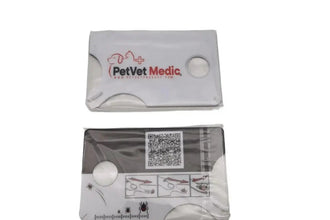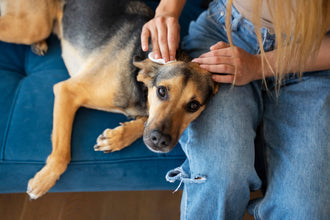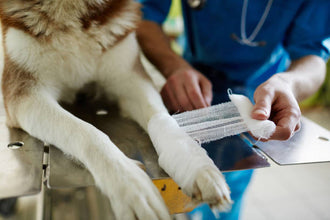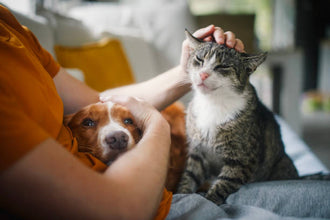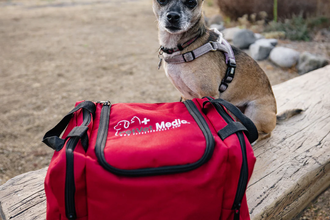
Every pet parent knows the joy of having a furry companion at home. But alongside the cuddles, walks, and unconditional love, comes responsibility. Pets—like humans—can face unexpected health emergencies. Whether it’s a cut from rough play, heatstroke on a hot day, or an accidental poisoning, being prepared with a pet first aid guide can make all the difference.
At PetVetProduct, we believe proactive care is the foundation of a safe and happy pet life. That’s why we created the Pocketbook Pet First Aid Guide a simple, accessible, and practical resource that helps pet parents act quickly and confidently when emergencies strike.
This blog is your ultimate pet first aid guide—designed to educate, prepare, and empower you to take care of your pets in urgent situations.
Why Every Pet Parent Needs a Pet First Aid Guide
Emergencies Happen When You Least Expect Them
Even the healthiest pets can experience accidents. Common scenarios include:
-
Dogs cutting their paws on sharp objects during walks.
-
Cats ingesting household toxins like lilies or cleaning products.
-
Heat exhaustion after outdoor play in summer.
-
Insect bites causing allergic reactions.
-
Collisions or falls resulting in sprains and fractures.
A dog first aid handbook or pet first aid chart and guide ensures you know what to do in the crucial minutes before reaching a vet.
The Critical Gap Between Home and the Vet
Veterinary care is essential, but emergencies don’t wait. Your pet’s outcome often depends on what you do immediately after the incident. With a pocket-sized pet first aid guide, you’ll have lifesaving steps at your fingertips.
Peace of Mind for Responsible Owners
Preparedness isn’t paranoia—it’s love in action. By equipping yourself with a pet first aid kit and an easy-to-use guide, you’re ensuring your pet gets the care they deserve.
Building Your Pet First Aid Kit
A first aid kit for dogs or cats should be as standard as one for humans. Pairing it with a pet first aid handbook makes it even more effective.
Essentials to Include:
-
Gauze pads & rolls – For bandaging wounds.
-
Adhesive tape – To secure dressings.
-
Antiseptic wipes/solution – To clean minor cuts.
-
Hydrogen peroxide (3%) – For inducing vomiting if instructed by a vet.
-
Digital thermometer – For checking fever or hypothermia.
-
Tweezers – For removing ticks or splinters.
-
Scissors (blunt-ended) – For cutting bandages or fur around wounds.
-
Instant cold pack – To reduce swelling.
-
Disposable gloves – For hygiene and safety.
-
Muzzle – To protect you and others, since even gentle pets may bite in pain.
-
Emergency blanket – To prevent hypothermia.
-
Eye rinse solution – For flushing irritants or chemicals.
Our PetVet Pocketbook Pet First Aid Guide pairs perfectly with these items, offering clear instructions on how to use them safely.
Common Pet Emergencies and First Aid Steps
The Pocketbook Guide provides quick-reference pet first aid charts to help in emergencies. Here’s a deeper look at some common scenarios every owner should prepare for:
1. Cuts and Bleeding
-
Apply gentle pressure with gauze.
-
Clean wound with antiseptic.
-
Bandage securely but not too tightly.
-
Seek vet care if bleeding is severe.
2. Choking
-
Gently open the mouth and check for objects.
-
Perform a modified Heimlich if necessary.
-
Rush to the vet if choking persists.
3. Poisoning
-
Common culprits: chocolate, grapes, onions, medications, cleaning products.
-
Call your vet or an emergency poison hotline.
-
Do not induce vomiting unless instructed.
4. Heatstroke
-
Symptoms: panting, drooling, collapse, red gums.
-
Move to shade, apply cool towels.
-
Offer small amounts of water.
-
Transport immediately to vet.
5. Hypothermia
-
Common in cold weather or wet environments.
-
Wrap pet in warm blankets.
-
Use body heat or warm water bottles (wrapped in cloth).
-
Seek vet care urgently.
6. Burns
-
Run cool water over the area for several minutes.
-
Do not apply ointments or butter.
-
Cover lightly with gauze before heading to the vet.
7. Snake or Insect Bites
-
Keep pet calm and restrict movement.
-
Apply a cold compress to reduce venom spread.
-
Get to the vet immediately.
8. Eye Injuries
-
Flush with sterile eye rinse solution.
-
Do not touch or rub the eye.
-
Cover with a clean cloth and see a vet quickly.
9. Seizures
-
Clear space around pet.
-
Do not restrain.
-
Time the seizure duration.
-
Allow rest after episode and call your vet.
10. Fractures & Sprains
-
Minimize movement.
-
Apply temporary splint if possible.
-
Transport gently.
The Role of Charts and Pocket Guides
Quick Reference in High-Stress Moments
During emergencies, it’s easy to panic. A pet first aid chart or Pocketbook guide provides calm, step-by-step instructions.
Portable and Accessible
Our Pocketbook Pet First Aid Guide fits into bags, glove compartments, or even your pet’s travel kit.
Complements Professional Veterinary Care
This guide doesn’t replace your vet—it supports them by ensuring your pet arrives in the best possible condition.
First Aid Tips for Active Pets and Travel
Pets are often most at risk during outdoor adventures or travel. The Pocketbook Guide ensures you’re ready anywhere.
Hiking and Camping with Dogs
-
Carry a first aid kit for dogs in your backpack.
-
Watch for ticks and insect bites.
-
Keep hydration available at all times.
Road Trips with Pets
-
Store your pet first aid kit in the car.
-
Include anti-nausea remedies and travel-safe water bowls.
-
Ensure your guidebook is accessible for roadside emergencies.
Home Preparedness
-
Keep kits in accessible locations.
-
Store emergency vet contact numbers with your kit.
-
Review the Pocketbook guide regularly to stay confident.
Pocketbook First Aid Guide by PetVetProduct
Our Pocketbook Guide is designed with pet parents in mind:
Features:
-
Clear first aid charts for fast reference.
-
Step-by-step instructions for common emergencies.
-
Compact size that fits into any kit.
-
Durable design for home or travel use.
This guide pairs seamlessly with a first aid kit for dogs and cats, ensuring you’re fully prepared at all times.
👉 Explore the Pocketbook Pet First Aid Guide today and give your pet the protection they deserve.
Conclusion: Be the Hero Your Pet Deserves
Pets rely on us for everything—food, comfort, love, and safety. Emergencies can happen anytime, but with the right tools and knowledge, you can respond effectively.
By equipping yourself with:
-
A pet first aid kit stocked with essentials.
-
A Pocketbook Pet First Aid Guide with step-by-step charts.
-
Preventive health practices and regular vet visits.
You’re ensuring your pet has the best chance of recovery and safety.
👉 Take the proactive step today. Explore the Pocketbook Pet First Aid Guide at PetVetProduct and be prepared for every situation.
Because when it comes to pets, preparedness isn’t optional—it’s love in action.
FAQs
A kit contains tools, while a guide gives you step-by-step instructions on using them effectively. Both are essential.
Keep pets leashed, avoid tall grass, and use the Pocketbook guide to manage bites until reaching a vet.
Heatstroke can occur above 80°F, while hypothermia risks start below 45°F if pets are wet or exposed.
Check every 6 months to replace expired or used supplies.
Never give human drugs unless specifically prescribed by a vet. Some common meds are toxic to pets.






